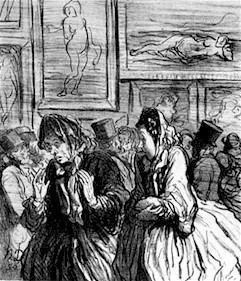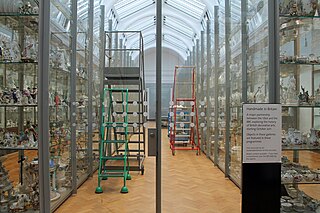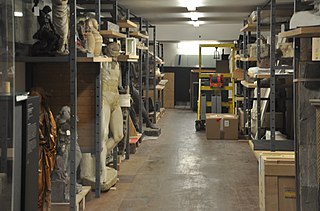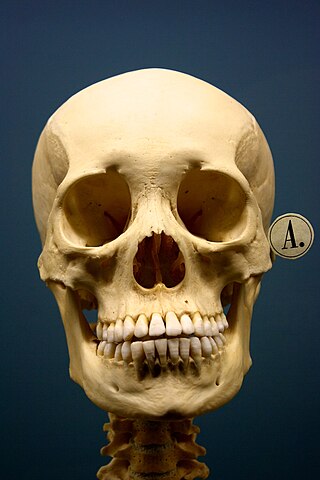
An art exhibition is traditionally the space in which art objects meet an audience. The exhibit is universally understood to be for some temporary period unless, as is occasionally true, it is stated to be a "permanent exhibition". In American English, they may be called "exhibit", "exposition" or "show". In UK English, they are always called "exhibitions" or "shows", and an individual item in the show is an "exhibit".

A museum is distinguished by a collection of often unique objects that forms the core of its activities for exhibitions, education, research, etc. This differentiates it from an archive or library, where the contents may be more paper-based, replaceable and less exhibition oriented, or a private collection of art formed by an individual, family or institution that may grant no public access. A museum normally has a collecting policy for new acquisitions, so only objects in certain categories and of a certain quality are accepted into the collection. The process by which an object is formally included in the collection is called accessioning and each object is given a unique accession number.

A conservator-restorer is a professional responsible for the preservation of artistic and cultural artifacts, also known as cultural heritage. Conservators possess the expertise to preserve cultural heritage in a way that retains the integrity of the object, building or site, including its historical significance, context and aesthetic or visual aspects. This kind of preservation is done by analyzing and assessing the condition of cultural property, understanding processes and evidence of deterioration, planning collections care or site management strategies that prevent damage, carrying out conservation treatments, and conducting research. A conservator's job is to ensure that the objects in a museum's collection are kept in the best possible condition, as well as to serve the museum's mission to bring art before the public.
Conservation and restoration of movable cultural property is a term used to denote the conservation of movable cultural property items in libraries, archives, museums and private collections. Conservation encompasses all the actions taken toward the long-term preservation of cultural heritage. Activities include examination, documentation, treatment, and preventive care, which is supported by research and education. Object conservation is specifically the actions taken to preserve and restore cultural objects. The objects span a wide range of materials from a variety of cultures, time periods, and functions. Object conservation can be applied to both art objects and artifacts. Conservation practice aims to prevent damage from occurring, a process known as 'preventive conservation'. The purpose of preventive conservation is to maintain, and where possible enhance, the condition of an object, as well as managing deterioration risks, such as handling and environmental conditions. Historically, object conservation was focused on the category of fine arts but now many different types of objects are conserved. Each type of object material, typically denoted by organic or inorganic then the specific medium, requires a specialized professional conservator and often requires collaborative work between museum staff, scientists, and conservators.

Collection maintenance is an area of collections management that consists of the day-to-day hands on care of collections and cultural heritage. The primary goal of collections maintenance or preventive conservation is to prevent further decay of cultural heritage by ensuring proper storage and upkeep including performing regular housekeeping of the spaces and objects and monitoring and controlling storage and gallery environments. Collections maintenance is part of the risk management field of collections management. The professionals most involved with collections maintenance include collection managers, registrars, and archivists, depending on the size and scope of the institution. Collections maintenance takes place in two primary areas of the museum: storage areas and display areas.

A collection manager ensures the proper care and preservation of objects within cultural institutions such as museums, libraries, and archives. Collection managers, along with registrars, curators, and conservators, play an important role in collections care. Collection Managers and Registrars are two distinct collection roles that are often combined into one within small to mid-size cultural institutions. Collection Managers can be found in large museums and those with a history and natural history focus whose diverse collections require experienced assessment to properly sort, catalog, and store artifacts. A collection manager may oversee the registrar, archivist, curator, photographer, or other collection professionals, and may assume the responsibilities of these roles in their absence within an organization.

A paintings conservator is an individual responsible for protecting cultural heritage in the form of painted works of art. These individuals are most often under the employ of museums, conservation centers, or other cultural institutions. They oversee the physical care of collections, and are trained in chemistry and practical application of techniques for repairing and restoring paintings.

Collections management involves the development, storage, and preservation of cultural property, as well as objects of contemporary culture in museums, libraries, archives and private collections. The primary goal of collections management is to meet the needs of the individual collector or collecting institution's mission statement, while also ensuring the long-term safety and sustainability of the cultural objects within the collector's care. Collections management, which consists primarily of the administrative responsibilities associated with collection development, is closely related to collections care, which is the physical preservation of cultural heritage. The professionals most influenced by collections management include collection managers, registrars, and archivists.

A conservation technician is a specialist in conservation methods pertaining to cultural property, and who may work in museums or public or private conservation organizations. A technician may also work in conjunction with other collection staff, such as a registrar (museum) or collection manager.

An Objects conservator is a professional, working in a museum setting or private practice, that specializes in the conservation of three-dimensional works. They undergo specialized education, training, and experience that allows them to formulate and implement preventive strategies and invasive treatment protocols to preserve cultural property for the future. Objects conservators typically specialize in one type of material or class of cultural property, including metals, archaeological artifacts, ethnographic artifacts, glass, and ceramic art. Objects conservation presents many challenges due to their three-dimensional form and composite nature.

A museum/library/archival registrar is responsible for implementing policies and procedures that relate to caring for collections of cultural institutions like archives, libraries, and museums. These policies are found in the museum's collections policy, the guiding tenet of the museum explaining why the institution is in operation, dictating the museum's professional standards regarding the objects left in its care. Registrars focus on sections that include acquisitions, loans, exhibitions, deaccessions, storage, packing and shipping, security of objects in transit, insurance policies, and risk management.

The documentation of cultural property is a critical aspect of collections care. As stewards of cultural property, museums collect and preserve not only objects but the research and documentation connected to those objects, in order to more effectively care for them. Documenting cultural heritage is a collaborative effort. Essentially, registrars, collection managers, conservators, and curators all contribute to the task of recording and preserving information regarding collections. There are two main types of documentation museums are responsible for: records generated in the registration process—accessions, loans, inventories, etc. and information regarding research on objects and their historical significance. Properly maintaining both types of documentation is vital to preserving cultural heritage.

The conservation and restoration of musical instruments is performed by conservator-restorers who are professionals, properly trained to preserve or protect historical and current musical instruments from past or future damage or deterioration. Because musical instruments can be made entirely of, or simply contain, a wide variety of materials such as plastics, woods, metals, silks, and skin, to name a few, a conservator should be well-trained in how to properly examine the many types of construction materials used in order to provide the highest level or preventive and restorative conservation.

A photograph conservator is a professional who examines, documents, researches, and treats photographs, including documenting the structure and condition of art works through written and photographic records, monitoring conditions of works in storage and exhibition and transit environments. This person also performs all aspects of the treatment of photographs and related artworks with adherence to the professional Code of Ethics.

A textile conservator is a conservator-restorer charged with the care, treatment, research, and preservation of textiles. Issues addressed by a textile conservator are generally related to the field of textile preservation, and include damage caused to textiles by: light, mold and mildew, insects, cleaning, surface cleaning, washing, mounting for display, and storage. Variations in textile types and "the diversity of the textile conservator's work makes it a very rewarding profession". Textiles are among the most fragile artifacts, as they are susceptible to damage from atmospheric pollutants, moisture, biological organisms, and environmental changes and care varies with size, shape, material, and condition issues, all of which a textile conservator must be well versed.

The conservation and restoration of totem poles is a relatively new topic in the field of art conservation. Those who are custodians of totem poles include Native American communities, museums, cultural heritage centers, parks or national parks, camp grounds or those that belong to individuals. Conservation activities include the historical research and context of totem poles, studying materials and manufacture, performing assessments, documentation and treatments. This field can pertain to conservator-restorers, Native Americans, curators, collection managers, registrars, park rangers and city planners.

The conservation and restoration of human remains involves the long-term preservation and care of human remains in various forms which exist within museum collections. This category can include bones and soft tissues as well as ashes, hair, and teeth. Given the organic nature of the human body, special steps must be taken to halt the deterioration process and maintain the integrity of the remains in their existing state. These types of museum artifacts have great merit as tools for education and scientific research, yet also have unique challenges from a cultural and ethical standpoint. Conservation of human remains within museum collections is most often undertaken by a conservator-restorer or archaeologist. Other specialists related to this area of conservation include osteologists and taxidermists.

Conservation-restoration of bone, horn, and antler objects involves the processes by which the deterioration of objects either containing or made from bone, horn, and antler is contained and prevented. Their use has been documented throughout history in many societal groups as these materials are durable, plentiful, versatile, and naturally occurring/replenishing.
The conservation-restoration of panel paintings involves preventive and treatment measures taken by paintings conservators to slow deterioration, preserve, and repair damage. Panel paintings consist of a wood support, a ground, and an image layer. They are typically constructed of two or more panels joined together by crossbeam braces which can separate due to age and material instability caused by fluctuations in relative humidity and temperature. These factors compromise structural integrity and can lead to warping and paint flaking. Because wood is particularly susceptible to pest damage, an IPM plan and regulation of the conditions in storage and display are essential. Past treatments that have fallen out of favor because they can cause permanent damage include transfer of the painting onto a new support, planing, and heavy cradling. Today's conservators often have to remediate damage from previous restoration efforts. Modern conservation-restoration techniques favor minimal intervention that accommodates wood's natural tendency to react to environmental changes. Treatments may include applying flexible battens to minimize deformation or simply leaving distortions alone, instead focusing on preventive care to preserve the artwork in its original state.

The Conservation of South Asian household shrines is an activity dedicated to the preservation of household shrines from South Asia. When applied to cultural heritage, held by either museums or private collectors, this activity is generally undertaken by a conservator-restorer. South Asian shrines held in museum collections around the world are principally shrines relate to Hindu, Jain, or Buddhist households. Due to their original use and sacred nature, these shrines present unique conservation and restoration challenges for those tasked with their care.



















